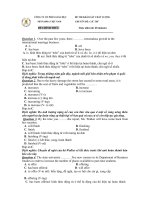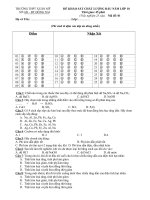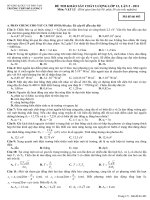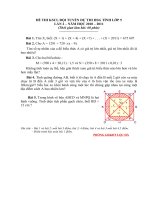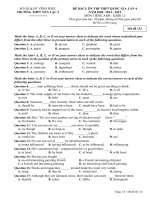Đề thi Khảo sát chất lượng Tiếng anh 2019 Trường Đồng Đậu, Vĩnh Phúc lần 1 mã đề 104 - Học Toàn Tập
Bạn đang xem bản rút gọn của tài liệu. Xem và tải ngay bản đầy đủ của tài liệu tại đây (351.52 KB, 5 trang )
<span class='text_page_counter'>(1)</span><div class='page_container' data-page=1>
<b>SỞ GIÁO DỤC VÀ ĐÀO TẠO </b>
<b>THPT ĐỒNG ĐẬU </b>
<b>ĐỀ THI KHẢO SÁT CHẤT LƯỢNG LỚP 12 LẦN 1 </b>
<b>MÔN : TIẾNG ANH </b>
<b>NĂM HỌC 2018-2019 </b>
<i>Thời gian làm bài: 60 phút </i>
<i>Đề gồm 50 câu </i>
<b>Mã đề thi 104 </b>
Họ, tên thí sinh:...
Số báo danh:...
<i><b>Read the following passage and mark the letter A, B, C, or D on your answer sheet to indicate the </b></i>
<i><b>correct answer to each of the questions. </b></i>
One of the most interesting authors of the twentieth century, J.R.R Tolkien, achieved fame through
his highly inventive trilogy. The Lord of the Rings. Born in 1892, Tolkien received his education
from Oxford and then served in World War I. After the war, he became a professor of Anglo -Saxon
and English language and literature at Oxford University.
Although published in 1965, the three books that comprise the Lord of the Rings were written
in intervals from 1936 to 1949. This was mainly due to Tolkien's responsibilities as a professor and
the outbreak of World War II. By the late 1960s, this fascinating trilogy had become a sociological
phenomenon as young people intently studied the mythology and legends created by Tolkien.
The trilogy is remarkable not only for its highly developed account of historical fiction but
also its success as a modern heroic epic. The main plot describes the struggle between good and evil
kingdom as they try to acquire a magic ring that has the power to rule the world. The novels, which
are set in a time called Middle Earth, describe a detailed fantasy world. Established before humans
populated the Earth, Middle Earth was inhabited by good and evil creatures such as hobbits, elves,
monsters, wizards, and some humans. The characters and the setting of Middle Earth were modeled
after mythological stories from Greece and Northern Europe.
Although readers have scrutinized the texts for inner meaning and have tried to connect the
trilogy with Tolkien's real life experiences in England during World War II, he denied the connection.
He claims that the story began in his years as an undergraduate student and grew out of his desire to
create mythology and legends about elves and their language.
Tolkien was a masterful fantasy novelist who used his extensive knowledge of folklore to
create a body of work that is still read and enjoyed throughout the world today.
<b>Câu 1: What can we assume is NOT true about Middle Earth? </b>
<b>A. Middle Earth was a fictional world. </b>
<b>B. People dominated Middle Earth. </b>
<b>C. Middle Earth was based on European folktales. </b>
<b>D. The good and evil kingdom fought for the power. </b>
<b>Câu 2: What does this paragraph mainly discuss? </b>
<b>A. All of J.R.R Tolkien's fantasy books. </b> <b>B. The popularity of J.R.R Tolkien. </b>
<b>C. J.R.R Tolkien and his trilogy. </b> <b>D. J.R.R Tolkien's work as a professor. </b>
<b>Câu 3: According to the passage, when did "the Lord of the Rings" trilogy become popular with </b>
<i>young people? </i>
<b>A. After World War II </b> <b>B. In 1892 </b>
<b>C. Between 1936 and 1946 </b> <b>D. In the late 1960s </b>
<b>Câu 4: When did Tolkien begin to create this trilogy? </b>
<b>A. When he was a professor </b> <b>B. When he was a student </b>
<b>C. During World War I </b> <b>D. During World War II </b>
</div>
<span class='text_page_counter'>(2)</span><div class='page_container' data-page=2>
<b>A. An unrelated group of books. </b> <b>B. A group of three literary books. </b>
<b>C. A specific type of fantasy novel. </b> <b>D. A long novel. </b>
<b>Câu 6: What is the setting of Tolkien's trilogy? </b>
<b>A. England in the 1800's. </b> <b>B. Oxford University. </b>
<b>C. Modem - day Greece. </b> <b>D. Middle Earth. </b>
<b>Câu 7: The word "</b><i><b>fascinating</b>" in the second paragraph could be replaced by ______. </i>
<b>A. boring </b> <b>B. thrilling </b>
<b>C. extremely interesting </b> <b>D. terrifying </b>
<i><b>Read the following passage and mark the letter A, B, C or D on your answer sheet to indicate the </b></i>
<i><b>correct word or phrase that best each of the numbered blank. </b></i>
Singapore has a highly developed market-based economy, (8)_______ historically revolves
around extended trade. Along with Hong Kong, South Korea and Taiwan, Singapore is one
(9)_______ The Four Asian Tigers. The economy depends heavily on exports , refining, imported
goods, especially in manufacturing. Manufacturing constituted 26 (10)_______ of Singapore’s GDP
in 2005. The manufacturing industry is well-diversified into electronics, petroleum refining,
chemicals, (11)_______ engineering and biomedical sciences manufacturing. In 2006, Singapore
produced about 10 percent of the world’s foundry water output. Singapore is the busiest port in the
world in terms of tonnage shipped. Singapore is the world’s fourth largest foreign exchange trading
centre after London, New York City (12)_______ Tokyo.
<b>Câu 8: </b> <b>A. who </b> <b>B. whom </b> <b>C. why </b> <b>D. which </b>
<b>Câu 9: </b> <b>A. in </b> <b>B. for </b> <b>C. of </b> <b>D. at </b>
<b>Câu 10: A. persuasion </b> <b>B. percentage </b> <b>C. percent </b> <b>D. perception </b>
<b>Câu 11: A. mechanically </b> <b>B. mechanic </b> <b>C. mechanical </b> <b>D. machine </b>
<b>Câu 12: A. so </b> <b>B. and </b> <b>C. or </b> <b>D. but </b>
<i><b>Mark the letter A, B, C or D on your answer sheet to indicate the sentence that is closest in </b></i>
<i><b>meaning to each of the following questions.</b></i>
<b>Câu 13: I did not answer the door even though I knew it was my friend. </b>
<b>A. Only when I answered the door did I knew it was my friend. </b>
<b>B. I knew it was my friend, but I did not answer the door. </b>
<b>C. Unless I knew it was my friend, I would not answer the door. </b>
<b>D. I answered the door since I knew it was my friend. </b>
<b>Câu 14: I didn’t know you were coming, so I didn’t wait for you. </b>
<b>A. Had I know you were coming, I would have waited for you. </b>
<b>B. If I had known you were coming, I would wait for you. </b>
<b>C. I would have waited for you if I knew you were coming. </b>
<b>D. If I had known you were coming, I would have waited for you. </b>
<b>Câu 15: "Why don't you ask the teacher for help?" Peter asked me. </b>
<b>A. Peter told me the reason why I did not ask the teacher for help. </b>
<b>B. Peter recommended me not to ask the teacher for help. , </b>
<b>C. Peter advised me to ask the teacher for help. </b>
<b>D. Peter suggested that he should ask the teacher for help. </b>
<i><b>Mark the letter A, B, C or D on your answer sheet to indicate the word or phrase that is </b></i>
<i><b>OPPOSITE in meaning to the underlined part in each of the following questions.</b></i>
<b>Câu 16: "That is a well-behaved boy whose behaviour has nothing to complain about" </b>
<b>A. behaving nice </b> <b>B. good behavior </b>
<b>C. behaving improperly </b> <b>D. behaving cleverly </b>
<b>Câu 17: After five days on trial, the court found him innocent of the crime and he was released. </b>
</div>
<span class='text_page_counter'>(3)</span><div class='page_container' data-page=3>
<i><b>Mark the letter A, B, C, or D on your answer sheet to indicate the most suitable response to </b></i>
<i><b>complete each of the following exchanges.</b></i>
<b>Câu 18: Laura is telling Bob about her exam results. </b>
- Laura: "______"
- Bob: "That's great. Congratulations!"
<b>A. I'll get the exam results tomorrow. </b> <b>B. I hope I'll pass the exam tomorrow. </b>
<b>C. I didn't do well in the exam. </b> <b>D. I've passed the exam with an A. </b>
<b>Câu 19: Peter: “_____________________” Jane: “Oh, thanks. I’m glad you like it.” </b>
<b>A. What does your house cost? </b> <b>B. I don’t know how to get to your house. </b>
<b>C. I like your house. It has nice view. </b> <b>D. Who designed this beautiful house? </b>
<i><b>Mark the letter A, B, C or D on your answer sheet to indicate the word whose underline part differs </b></i>
<i><b>from three in the position of primary stress in each of the following questions</b></i>.
<b>Câu 20: A. economy </b> B. economics C. technologically <b>D. institution </b>
<b>Câu 21: A. international </b> <b>B. university </b> <b>C. agricultural </b> <b>D. philosophy </b>
<i><b>Mark the letter A, B, C or D on your answer sheet to indicate the word whose underline part differs </b></i>
<i><b>from three in pronunciation in each of the following questions. </b></i>
<b>Câu 22: A. replied </b> B. achieved C. established <b>D. required </b>
<b>Câu 23: A. existence </b> <b>B. exciting </b> <b>C. experience </b> <b>D. explanation </b>
<i><b>Mark the letter A, B, C or D on your answer sheet to indicate the correct answer to each of the </b></i>
<i><b>following questions</b></i>.
<b>Câu 24: Most doctors and nurses have to work on a _______ once or twice a week at the hospital. </b>
<b>A. solution </b> <b>B. household chores </b> <b>C. special dishes </b> <b>D. night shift </b>
<b>Câu 25: They_______small cup of coffee after they_______dinner. </b>
<b>A. drank/had finished </b> <b>B. drink/ had finished </b> <b>C. drunk/had finished </b> <b>D. drunk/finished </b>
<b>Câu 26: It is said the Robinhood robbed______ rich and gave the money to ______ poor. </b>
<b>A. the/ a </b> <b>B. a/ the </b> <b>C. the/ the </b> <b>D. a/ a </b>
<b>Câu 27: The villagers in this commune continue to take part in many __________ceremonies. </b>
<b>A. untraditional </b> <b>B. traditional </b> <b>C. traditionally </b> <b>D. traditions </b>
<b>Câu 28: She _______ working on that manuscript for 2 years now. </b>
<b>A. had been </b> <b>B. is </b> <b>C. has been </b> <b>D. will be </b>
<b>Câu 29: Sometimes she does not agree _______ her husband about child rearing but they soon find </b>
the solutions.
<b>A. on </b> <b>B. with </b> <b>C. of </b> <b>D. for </b>
<b>Câu 30: He __________for Canada two years ago and I __________him since then. </b>
<b>A. left / do not see </b> <b>B. has left / have not seen </b>
<b>C. left / did not see </b> <b>D. left / have not seen </b>
<b>Câu 31: The students' plan for a musical show to raise money for charity received ______ support </b>
from the school administrators.
<b>A. big-hearted </b> <b>B. whole-hearted </b> <b>C. warm-hearted </b> <b>D. light-hearted </b>
<b>Câu 32: Tom was still keen on his goal __________ it was very hard to achieve. </b>
<b>A. despite </b> <b>B. although </b> <b>C. in spite </b> <b>D. because </b>
<b>Câu 33: You stayed home last night, _________? </b>
<b>A. didn't you </b> <b>B. had you </b> <b>C. did you </b> <b>D. would you </b>
</div>
<span class='text_page_counter'>(4)</span><div class='page_container' data-page=4>
<b>Câu 35: It is very kind of you __________me a hand. </b>
<b>A. to give </b> <b>B. given </b> <b>C. giving </b> <b>D. give </b>
<i><b>Mark the letter A, B, C or D on your answer sheet to indicate the word or phrase that is CLOSEST </b></i>
<i><b>in meaning to the underlined part in each of the following questions.</b></i>
<b>Câu 36: "He insisted on listening to the entire story". </b>
<b>A. whole </b> <b>B. funny </b> <b>C. interesting </b> <b>D. part </b>
<b>Câu 37: The air has become more and more polluted because of exhaust fumes from vehicles. </b>
<b>A. contaminated </b> <b>B. conserved </b> <b>C. wasted </b> <b>D. preserved </b>
<i><b>Mark the letter A, B, C or D on your answer sheet to indicate the underlined part that needs </b></i>
<i><b>correction in each of the following questions.</b></i>
<b>Câu 38: The students are going to hearing three short conversations about food. </b>
<b>A. going </b> <b>B. hearing three short </b> <b>C. about food </b> <b>D. the students </b>
<b>Câu 39: No sooner had the wind stopped blowing when it started to rain heavily. </b>
<b>A. heavily </b> <b>B. had </b> <b>C. stopped blowing </b> <b>D. when </b>
<b>Câu 40: I feel both excited and nervously because I will have an interview tomorrow. </b>
<b>A. nervously </b> <b>B. have </b> <b>C. excited </b> <b>D. feel </b>
<i><b>Mark the letter A, B, C, or D on your answer sheet to indicate the sentence that best combines each </b></i>
<i><b>pair of sentences in the following questions.</b></i>
<b>Câu 41: The man was shot in the bank robbery. The doctors are operating on him. </b>
<b>A. The man was whom the doctors are operating on him shot in the bank robbery. </b>
<b>B. The man was shot in the bank robbery where the doctors are operating on him. </b>
<b>C. The man whom the doctors are operating on him shot in the bank robbery. </b>
<b>D. The doctors are operating on the man shot in the bank robbery. </b>
<b>Câu 42: Mike ate lots of ice-cream. That’s why he had a headache. </b>
<b>A. If Mike hadn’t eaten much ice-cream, he wouldn’t have a headache. </b>
<b>B. If Mike hadn’t eaten much ice-cream, he wouldn’t have had a headache. </b>
<b>C. If Mike didn’t eat much ice-cream, he wouldn’t have a headache. </b>
<b>D. Mike had a headache because he has eaten lots of ice-cream. </b>
<i><b>Read the following passage and mark the letter A, B, C, or D on your answer sheet to indicate </b></i>
<i><b>the correct answer to each of the questions . </b></i>
Smart cards and mobile phones are becoming an increasingly popular way to make all sorts of
payments. Even now, in Japan thousands of transactions, from paying rail tickets to picking up the
groceries, take place every day with customers passing their handsets across a small flat-screen
<b>device. And predictions in the world of finance reckon that payments using mobile phones will have </b>
risen to more than $50 billion in the very near future.
What's the appeal of e-cash? Compared to cheques or credit cards, it offers the speed of
cash, but more so. It takes just one tenth of a second to complete most transactions and as no change
is required, errors in counting are eliminated. Fraud and theft are also reduced and for the retailer, it
reduces the cost of handling money. Sony's vision of having a chip embedded in computers, TVs and
games consoles means that films, music and games can be paid for easily without having to input
credit card details.
And what about the future of the banks? Within their grip on the market, banks and
credit-card firms want to be in a position to collect most of the fees from the users of mobile and
</div>
<span class='text_page_counter'>(5)</span><div class='page_container' data-page=5>
banks will miss out and if so, by how much. However, quite a few American bankers are optimistic.
They feel there is reason to be suspicious of those who predict that high-street banks may be a thing
of the past. They point out that Internet banking did not result in the closure of their high-street
branches as was predicted. On the contrary, more Americans than ever are using local branches. So,
whether we'll become a totally cash-free society remains open to contention.
<b>Câu 43: What is the main idea of the first paragraph? </b>
<b>A. The increasing popularity of new payment methods. </b>
<b>B. The absence of traditional payment methods. </b>
<b>C. Predictions of future payment methods. </b>
<b>D. Japan's advanced forms of payment. </b>
<b>Câu 44: Why does the author mention "a small flat-screen device" in the first paragraph? </b>
<b>A. to praise the e-cash system </b> <b>B. to criticize the e-cash system </b>
<b>C. to exemplify the e-cash system </b> <b>D. to inform the e-cash system </b>
<b>Câu 45: Which of the following is NOT true about the strong point of e-cash? </b>
<b>A. no fraud </b> <b>B. fewer mistakes </b> <b>C. faster speed </b> <b>D. reduced cost </b>
<b>Câu 46: The word "embedded” in the second paragraph is closest in meaning to ________. </b>
<b>A. isolated </b> <b>B. manufactured </b> <b>C. integrated </b> <b>D. generated </b>
<b>Câu 47: The word "grip" in the third paragraph is closest in meaning to ________. </b>
<b>A. range of branches </b> <b>B. wealth </b> <b>C. success </b> <b>D. power </b>
<b>Câu 48: The author mentions the case of commuters in the third paragraph to illustrate ___. </b>
<b>A. a possible drawback of the system </b>
<b>B. the banks' cooperation with credit-card companies </b>
<b>C. the modern technology of the e-cash system </b>
<b>D. the transferability of the system </b>
<b>Câu 49: The word "their” in the third paragraph refers to ________. </b>
<b>A. American bankers </b> <b>B. Internet banking </b> <b>C. high-street hanks </b> <b>D. credit cards </b>
<b>Câu 50: How does the writer seem to feel about the future of banks? </b>
<b>A. neutral </b> <b>B. uncertain </b> <b>C. optimistic </b> <b>D. pessimistic </b>
---
</div>
<!--links-->

